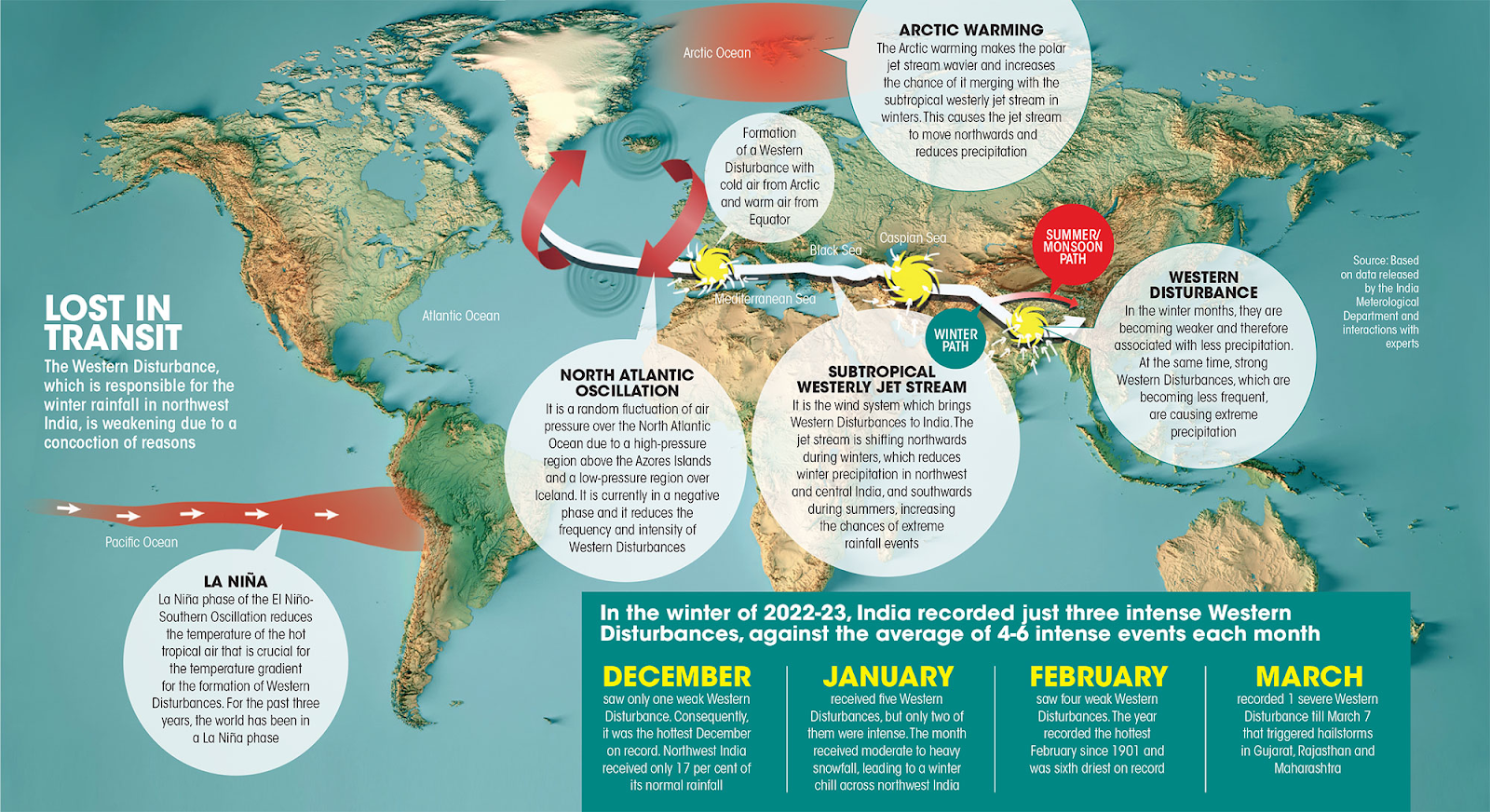Changing Western Disturbances | 27 Mar 2023
For Prelims: Western Disturbances, Flash floods, Mediterranean region, Caspian Sea, Himalayan glacier, Rabi Crop.
For Mains: Western Disturbances, Significance of Western Disturbances for India.
Why in News?
According to recent studies, the changing character of Western Disturbances might be the primary cause of the abnormal winter seasons in India.
- India has not experienced a normal winter season in the past three years. The second wettest season in the country after the monsoons has remained unusually dry and hot.
How Western Disturbances Affected Winters in India Recently?
- The northwest region of India, which receives almost 30% of its annual rainfall during the winter season, saw an 83% and 76% rainfall deficit in December 2022 and February 2023 respectively.
- The absence of Western Disturbances caused the north Indian plains to experience severe cold waves and cold days in December 2022 and most of January 2023 due to the cold northern winds flowing down from the Himalayas.
- Western Disturbances are also responsible for hailstorms that damage standing crops, fog events that interrupt air, rail and road services and cloud bursts that result in flash floods.
What are Western Disturbances?
- About:
- Western Disturbances are a series of cyclonic storms that originate in the Mediterranean region, travel over 9,000 km to bring winter rains to northwest India.
- A Western Disturbance collects moisture from the Mediterranean Sea, Black Sea, and Caspian Sea and traverses over Iran and Afghanistan before hitting the western Himalayas.
- While the storm systems occur throughout the year, they travel to India mostly between December and April because the trajectory of the subtropical westerly jet stream, which transports them, shifts during the winter months to the rim of the Himalayas.
- For the rest of the year, the jet stream travels from above the Himalayas to the Tibetan Plateau and China. Its trajectory changes as per the position of the Sun.
- Western Disturbances are a series of cyclonic storms that originate in the Mediterranean region, travel over 9,000 km to bring winter rains to northwest India.
- Significance for India:
- Western Disturbances are the primary source of snowfall that replenishes the Himalayan glaciers during winter.
- These glaciers feed major Himalayan rivers like the Ganga, Indus and Yamuna as well as myriad mountain springs and rivulets.
- These low-pressure storm systems help farmers in India grow their rabi crop.
- Western Disturbances are the primary source of snowfall that replenishes the Himalayan glaciers during winter.
- Issues:
- The Western Disturbances are not always the harbingers of good weather. Sometimes WDs can cause extreme weather events like floods, flash floods, landslides, dust storms, hail storms and cold waves, destroying infrastructure and impacting life and livelihoods.
How Western Disturbances are Affected by Other Climatic Phenomena?
- La Nina Event:
- For the past three years, the world has been in a La Niña phase, which refers to the cooling of ocean surface temperature in the Pacific Ocean.
- It weakens the temperature gradient for the formation of Western Disturbances as it reduces the temperature of the hot tropical air.
- For the past three years, the world has been in a La Niña phase, which refers to the cooling of ocean surface temperature in the Pacific Ocean.
- North Atlantic Oscillation:
- Western Disturbances are also influenced by the North Atlantic Oscillation, a random fluctuation of air pressure over the North Atlantic Ocean due to a high-pressure region above the Azores Islands in the central North Atlantic and a low-pressure region over Iceland.
- Due to this, the weather system is currently in a negative phase, as both low- and high-pressure systems are weak, and it makes Western Disturbances 20% less frequent and 7% less intense than a positive phase.
- Western Disturbances are also influenced by the North Atlantic Oscillation, a random fluctuation of air pressure over the North Atlantic Ocean due to a high-pressure region above the Azores Islands in the central North Atlantic and a low-pressure region over Iceland.
- Subtropical Jet Stream:
- The northward shift of the subtropical westerly jet stream not only reduces the chance of Western Disturbances striking India but also increases the chance of them affecting higher latitudes such as the Tibetan Plateau or even as far up as China and Russia.
- This could indirectly affect the southwest monsoon, which accounts for 80% of India’s annual rainfall.
- The northward shift of the subtropical westerly jet stream not only reduces the chance of Western Disturbances striking India but also increases the chance of them affecting higher latitudes such as the Tibetan Plateau or even as far up as China and Russia.
- Interaction with Southwest Monsoon:
- The warming of the Arctic region makes the polar front jet wavier, causing Western Disturbances to visit India more frequently during summers.
- Western Disturbances during summer, monsoon, and post-monsoon periods increase the chances of them interacting with the southwest monsoon and other associated local convection systems such as tropical depressions that travel northward from either the Bay of Bengal or the Arabian Sea.
- Such interactions can cause catastrophic weather disasters.
- For instance, In May 2021, a remnant of the extremely severe cyclone Tauktae, which made landfall along the Gujarat coast, travelled all the way to Delhi and interacted with a Western Disturbance to cause heavy rainfall in Delhi and its vicinity.
UPSC Civil Services Examination, Previous Year Questions (PYQ)
Q. Consider the following statements: (2009)
- In the world, the tropical deserts occur along the western margins of continents within the trade wind belt.
- In India, the East Himalayan region gets high rainfall from north-east winds.
Which of the statements given above is/are correct?
(a) 1 only
(b) 2 only
(c) Both 1 and 2
(d) Neither 1 nor 2
Ans: (a)

